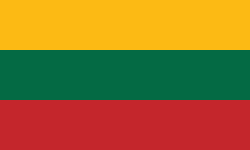Alytus district municipality (Alytaus rajonas)
 |
This municipality was founded in 1950, and until 1953 was a part of the Kaunas Province. In 1959, another reorganization of parts of the former Simnas and Daugai municipalities occurred, which included the towns of Simnas and Daugai. In 1962 it was expanded more, attaching part of the former Jieznas municipality. In 1968 parts of the municipality were attached to the Prienai District Municipality and Trakai District Municipality, and 1969 another part of Varėna District Municipality.
The current Coat of Arms of the Alytus district municipality was announced by Lithuanian presidential decree on August 7, 2001.
Alytus District Municipality has 72 archeological, 395 historical, 144 art, 29 architectural and 3 urbanistic monuments, as well as 19 hillforts.
Map - Alytus district municipality (Alytaus rajonas)
Map
Country - Lithuanian_Soviet_Socialist_Republic_(1918–1919)
 |
 |
| Flag of Lithuania | |
Germany had lost World War I and signed the Compiègne Armistice on 11 November 1918. Its military forces then started retreating from the former Ober Ost territories. Two days later, the government of the Soviet Russia renounced the Treaty of Brest-Litovsk, which had assured Lithuania's independence. Soviet forces then launched a westward offensive against Estonia, Latvia, Lithuania, Poland and Ukraine in an effort to spread the global proletarian revolution and replace national independence movements with Soviet republics. Their forces followed retreating German troops and reached Lithuania by the end of December 1918.
Currency / Language
| ISO | Currency | Symbol | Significant figures |
|---|---|---|---|
| EUR | Euro | € | 2 |
| ISO | Language |
|---|---|
| LT | Lithuanian language |
| PL | Polish language |
| RU | Russian language |















